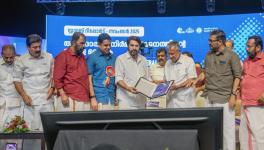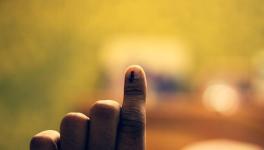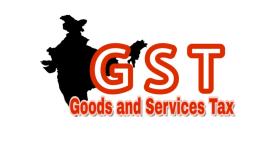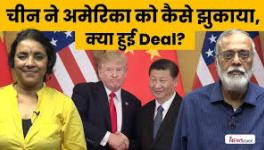Trump 2.0 is Modi’s Natural Ally, And His Worst Dream
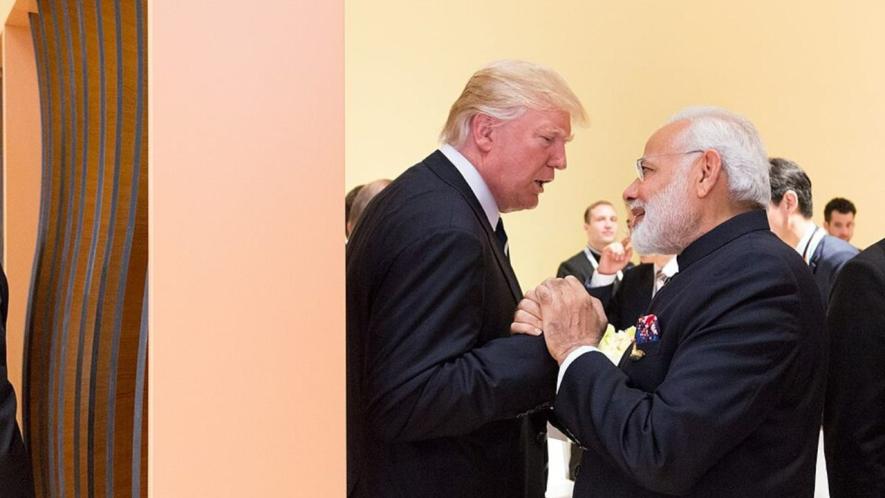
Image Courtesy: Wikimedia Commons.
Quite possibly, rarely anything before has managed to grab the attention of the whole world, on an everyday basis, on entirely different issues, as much as the 50th President of the US, Donald Trump. The period since January 20 has really brought the world at the cusp of what many newspapers, analysts, magazines have interchangeably called ‘structural transformation’, ‘historical changes’, or the coming of a ‘new world order’.
Yet, while these analysts are correct on highlighting the potential changes being brought by this US Administration, these changes should not be seen as sudden, and are rather conscious political responses to the period of globalisation, neoliberalism (and their discontents) that the US Right has managed to popularise and, therefore, has gained substantial support.
Narendra Modi, a pracharak of RSS and someone who has also been long associated with the US through being in the State Department’s Young Leaders Council in 1994, for example, is an important part of the rise of the Right globally. Coming to head India’s government in 2014, with Trump coming to power in 2016, both found ideological, political, and personal similarities with each other that cemented the view that India and the US will have a longer-term partnership and get ever closer not just due to perceived strategic and geopolitical reasons, but also due to the friendship between the two leaders. As is well known, both the leaders dislike the multicultural fabric of their country and wish to impose their supremacist beliefs on their people.
By 2019, Trump’s tariff radar had begun to be swung toward India, with the latter being removed from the US' Generalised System of Preferences programme, but this did not have a drastic any impact on India’s exports to the US. In fact, some sectors observed a rise, and the US action did not generate large concern in India. All, in the world of Trump and Modi, seemed tuned for their brotherly love to grow where Trump would occasionally appreciate him as an important leader and a personality of global significance, and that was enough for Modi’s domestic theatrical needs.
The conclusion of Operation Sindoor brought about a tearing embarrassment for Modi, and has halted all daydreams about Modi’s relationship with Trump and his geopolitical muscle. The period since Operation Sindoor also showed that for the US, Pakistan remains an important military ally that will not be abandoned for India. Pakistan’s military establishment, on its part, has historically been the closest US ally in South Asia and has shown a sustained intent to remain this way.
The act of hyphenating India and Pakistan, of warming up to Pakistan Army chief Asim Munir and of Trump’s claiming credit for ‘restoring peace’, all served to almost shock India’s establishment. It certainly did not expect a US military officer to be as blunt about India being a dispensable state that is not important enough for the US to punish Pakistan or downgrade its relationship with it.
Yet, to be surprised by this would be to belie the nature of US foreign policy. Since 2017, when the term ‘Indo-Pacific’ was first formally used in US State documents, both India and the US have expressed a deepening intent for strategic alliance with each other.
Within the US establishment, ‘Indo-Pacific’ was directed as the area that would demand the primary focus of the US for the period to come, and this started with the making of the informal QUAD alliance when the US drew India, Japan and Australia into its umbrella for drumming up tensions, if not conflict, against its only real geopolitical rival – China.
Across the two parties in the US, there is a consensus that India would be a necessary ally who – regardless of its shrinking diplomatic weight, marginal economic might, and disadvantaged military capability vis-à-vis China – would have to be convinced that its own interests cannot go together with China, and that the political approach that the Indian government must have is one of hostility and irreconcilability, backed by the idea of being the ‘regional challenger’ to China.
Of course, with this process, the US hopes to draft India for its own multi-front war with China, and so far, the Indian government has shown a great deal of enthusiasm for this. For India, joining the QUAD bloc, an alliance of ex-colonial powers with the decisive objective of ‘containing’ China, was itself a major indication of things to come and a watershed moment in its foreign policy. But it has been reported that the US, since the past couple of years, has been unhappy with India’s reluctance to transform it into a military pact.
The US, therefore, has experimented with formation of other blocs too, such as the SQUAD – which is the same set of countries, except instead of India, there is the Philippines – a treaty ally of the US. On the other hand, and by the beginning of 2024, the US – which previously criticised Pakistan’s involvement in Afghanistan – began warming up and having favourable diplomatic channels with it. The central factor was the Pakistani military’s ouster and jailing of former Prime Minister Imran Khan under pressure from the US, reportedly due to his disapproval of US policy prescriptions in the region, especially with China and the Russia-Ukraine war.
What Does Trump Want from Modi?
All this, however, is nowhere to argue that the US intends to abandon India or antagonise it. For any country in the contemporary world, the emerging rivalry between the two largest economies of the world has placed them in a situation where they increasingly double-think about the consequences of each of their actions.
Much to the relief of the US, India appears to believe that it is naturally antagonistic to China, although currently economically dependent on it – and this puts India, regardless of its stated vision, into the geopolitical group surrounding the US and NATO (North Atlantic Treaty Organisation). The bet of the US is placed on exploiting this strategic vulnerability of India to exact unequal economic and trade deals which will improve the rapidly declining imperial position of the US. This is the larger modus-operandi that the US under Trump intends to impose across the world, and especially on his allies who are either economically, geographically, or have historically been dependent on it.
Let us take the India-US trade deal for instance. Negotiations have been in the process for the past several months, and even an interim trade deal has so far been difficult, despite the impending pressure of US tariffs. The reason is clear: the US is not satisfied with the concession on digital tax, or the nuclear liability laws, or the promises of drastically increasing purchase of US weapons and oil.
The US will only agree to a deal where India’s agricultural and dairy sector is opened for access to the tremendously subsidised US farmers. India, where 85% of the farmers in total are small and marginal, and where eight crore persons are directly employed by the dairy sector contributing 5% to the GDP, would experience a devastation on their entire livelihood due to cheaper foodgrains, dairy products, GM crops, and ethanol – all receiving incomparable state support in the US.
Add to this Trump’s tariff threats to pharmaceutical imports, his threats to BRICS nations for daring to de-dollarise, and his threats to India for importing cheaper Russian oil. It becomes clear that the method being used here by the US is not of a ‘trade talk’, but of throwing a barrage of threats against India’s vulnerabilities where it will be forced to give up on something, or all, and get nothing in return.
And yet, India is not the only country experiencing this. It is the deliberate strategy by the US to diminish, or even delegitimise the multilateral institutions of its own creation, to push individual countries against a wall and squeeze them to the maximum. Such exaction of economic bounty from other countries is, after all, necessary for a country that is indebted of $37 trillion, and projected to add at least $3 trillion more to its debts in a decade solely because of Trump’s ‘Big Beautiful Bill’.
The trade strategy of the US, of ‘Making America Great Again’ is, therefore, about transferring the costs of its military expenditures, of the cost of its tax cuts, of payment of its accumulated debts onto the population of the world, in the form of unequal trade deals that benefit the corporations of the US as well as the government.
In the beginning of the 20th century, tariffs were a favourite economic policy of the Republicans, in which federal revenues from trade were seen as the major source of government finances, while corporate or income taxes were kept minimum. This was the policy that was broadly implemented by Herbert Hoover (the 31st US President) in 1929-30 with renewed vigour, which resulted in the collapse of global trade and worldwide conflicts. It will not be an understatement that Trump stands at a similar juncture today.
Will Modi Respond or Abide?
While one may be prone to think of Trump as a madman, let us be clear that there is a definite method to his madness. Many countries have not wasted their time trying to reason with him, and have instead been resolute in defending their sovereignty, and even territorial integrity against his threats and proposals. Mark Carney, a member of the Liberal Party of Canada that had some of the highest disapproval ratings in recent times, became relevant and popular due to his clear stance against Trump’s demand for Canada’s accession. Similar was the case with Australia, whose Anthony Albanese has not shown an inclination toward sacrificing Australia’s interests in engaging with China because of US pressure.
Most of all, Ayatollah Khamenei, the Supreme Leader of Iran whose people display regular frustration with the theocratic regime, found an all-round support due to US and Israel’s aggression and threat to the Iranian State and its people’s lives. Being anti-Trump and strongly asserting their country’s sovereignty, that is, has bolstered many political parties in the past six months.
There are many other leaders, too, who have given stern pushbacks to Trump because of his new policies, such as China’s Xi Jinping, and Brazil’s Lula da Silva recently, both part of the BRICS’ grouping.
Modi, however, has remained ominously silent in response to India being called a ‘tariff king’ and Trump taking credit for ‘resolving’ the Pahalgam crisis between India and Pakistan. For Modi, such a relationship with and response from the US must be a serious wound on his ‘Vishwaguru’ image.
Modi, however, hardly has an option to retaliate in substance and will largely comply with most of the US pressures, for two key reasons. The economic relationship between the US and India is not where India has any leverage over the US whatsoever. Unlike China, which cultivated industrial supply chains that are difficult to move out from and required much larger upfront investment, India’s IT hubs are easier to replace simply because they are easier to replicate.
Our services exports – that has grown much faster than merchandise over the past 10 years – which form 44% of our total exports, are also dominantly sent to the US. While government data on this is not available, reports suggest 60-70% reliance for export revenues by our IT firms on the US market. Therefore, any tariffs, or threat of relocation of these service exports – which is arguably one of the only areas of Indian economy that rose due to neoliberalism – would jeopardise India’s exports and the balance of our external account.
Next, since India has an overall trade deficit with the rest of the world, it desperately depends on financial inflows to balance this. These inflows are, predominantly, originating from the US.
The Securities and Exchange Board of India (SEBI) has highlighted that US investors account for 30% of total portfolio investments by number, and also account for 39.2% of total FPIs (foreign portfolio investors) by value of assets. Any breakdown in US-India relationship (for example, the US sanctioning India, which will be US’ natural response in case of India’s policy shift) would threaten the exit of much of these financial flows from India, again harming our external account and potentially leading to a crisis in balance of payments.
It is important to understand that such a dependency on the US is our basic relationship since neoliberalism. An end to such a relationship, therefore, would require a politics far different from that of the Bharatiya Janata Party (BJP) and Modi.
Lastly, there is a strong belief in the Indian government that if ever we are to see a rise of manufacturing exports, the US will be India’s primary export market, and also where India will find its FDI (foreign direct investment) from. This belies the reality, in that over the last couple of years, it is China and Japan that have increased or maintained their FDI outflows, while the US has dramatically dropped it, from $360 billion in 2023 to $266 billion in 2024, according to an UNCTAD report. This trend will only strengthen with Trump’s MAGA (Make America Great Again) campaign and his pressure on US companies to invest in the US.
Meanwhile, while the US has remained India’s biggest market in both merchandise and services, it is widely understood that its role in world economy is diminishing in the long-term, driven by slower economic growth and shift in centre of economic gravity to East Asia, marked by the largest trade deal in history, RCEP (Regional Comprehensive Economic Partnership). The BRICS officially overtook the G7 in the share of world GDP in 2017.
Modi’s decision to stay out of East Asian trade blocs and put all its eggs in America’s basket – in a relationship that is destined to shift for the worse with Trump’s policy of ‘balancing the trade’ – could likely make India even more vulnerable to US dictates.
The coming period is surely one of great turbulence for India, marked either by cementing India’s subordinate role to the US under Modi, or by challenging the very basis of this relationship since neoliberalism.
Ananya Kumar is a student at International Development Economics Associates (IDEAs). The views are personal. He can be reached at anany.kumar.19@gmail.com.
Get the latest reports & analysis with people's perspective on Protests, movements & deep analytical videos, discussions of the current affairs in your Telegram app. Subscribe to NewsClick's Telegram channel & get Real-Time updates on stories, as they get published on our website.










